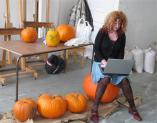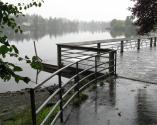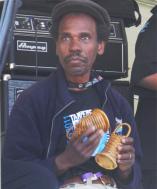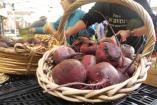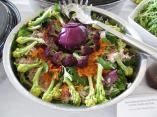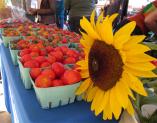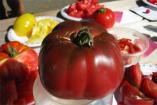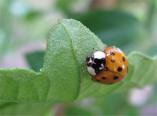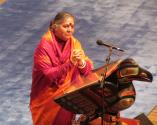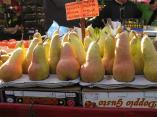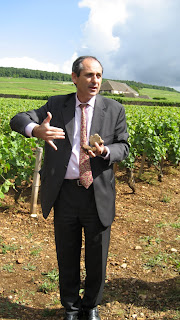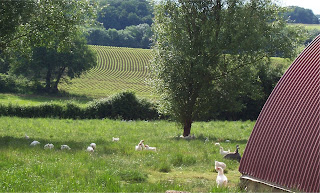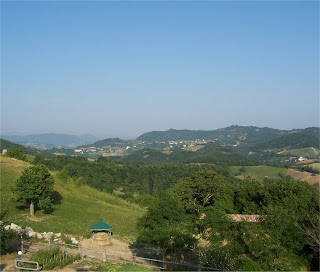On Friday, we visited the Château de Corton-André, to hear about the wines of Pierre André from Christian Ciamos. He told us first about the yellow tiled roof of the chateau, which had come from Bruges and which was one of few in the area, an emblem of nobility dating back to the power days of the dukes of Burgundy. The château itself had been built on Cistercian cellars: the Cistercian monks were the first vintners of the area and established most of the vineyards and techniques still in use in Burgundy wines.
In the fields, he talked about the moves to organic and biodynamic methods of cultivation that he and other winemakers are making. Basically, he said, it’s a question of respecting nature. Hence the roses still grown at the ends of many vineyards: they are prone to the same fungal attacks as vines and will show evidence before the vines do.
The vines of Pierre André are treated for disease, he said, not the risk of disease, otherwise you kill both the illness and the ecosystem. He and others we’d heard from during the week came back to their incontrovertable truth: that living things that are not routinely treated with chemicals (whether pesticides or antibiotics) are fundamentally more healthy and able to resist disease than those you make dependent on chemical cures. There is again no irrigation in use here: the vines are made healthier by having to sink their roots deep into the soil to find water.
We then retired to the cellar to have a tasting of wines from 2003 and 2004, and picked up an interesting snippet about wine tasting: there are three noses in wine – when it’s just poured in the glass; when it’s been swirled; and when the glass is empty.
A big excitement later that afternoon was the visit to François Frères Cooperage, where we watched barrels being made. The company makes most of its own staves from lumber purchased at auction, and trims the pieces to size in a small mill on its property. The staves are then aged for two years before being trimmed again and formed into barrels. The most dramatic moment was the toasting, where the half made barrels are placed over fires so that the heat relaxes the wood and flavours it to the specification of the buyer.
Before we knew it, Monday had arrived and it was our last day in France.
We visited Gaugry, a family-run cheese factory near Dijon, to learn about the making of Epoisses. This is one of the soft smelly French cheeses that I’ve never been wild about, but I enjoyed the tastings, and found my favourite of the three we tried was mild, creamy and firm – a much gentler taste than the aroma suggested. It was nice, though not enough to cause me to risk the aromatic integrity of my fridge in Parma by bringing some back with me, but I will look forward to tasting it again one day.
It’s a slow-coagulated, hand-salted cheese that is molded and dried before beginning a month or so of washings several times a week in marc de bourgogne (a wine solution) which gives it the orange colour we know it by.
We tried three different versions: two raw milk (one a farmer’s cheese and the other made at the Gaugry factory) and one pasteurised, for markets like the US where raw milk cheeses can’t be sold. A tip for the interested is that pasteurised versions are runnier than raw milk ones, so it’s easy to spot the outsider among these three:
We had a few hours in a very warm room at the top of the Burgundy school of business in Dijon, where Peter Dunn walked us through the massively confusing layers of names and quality marks for Burgundy wines. It was new information to me on the Bordeaux Classification of 1855 and some helpful review of AOC requirements for French wine. It was more on exposure, water, soil, limestone, marl and weather systems, and a bit on pruning and vinification.
But before that, we were subjected to what may be the worst meal ever served (and not, in most cases, eaten): the cafeteria of the business school in Dijon. Curiously, they were offering this abomination during a student recruitment drive. The first photo was an unidentifiable deep fried something that was described as having a ‘bolognese’ filling; it was served on a mystery grain.
The vegetables had been cooked into some kind of alternate chemical existence; it was as if they had gone beyond their roles as long dead plants into some new and appalling incarnation that could not properly be described as a life form.
It was puzzling to us: why had we been brought here? Was there a learning point in this mealtime? This was not slow food; but neither was it particularly fast, and it was fairly certainly not even food.
When we had completed our close observation and dissection of the substances, and drunk our cups of water, we were directed to a large bin in the corner where everything – the ‘food’, plastic cutlery, plastic plates, paper cups and napkins – were tipped into a plastic-lined void. A perfect finale: this school doesn’t trouble itself with either edible meals or recycling. I wonder what other lessons the business students take away from this place when they graduate.
